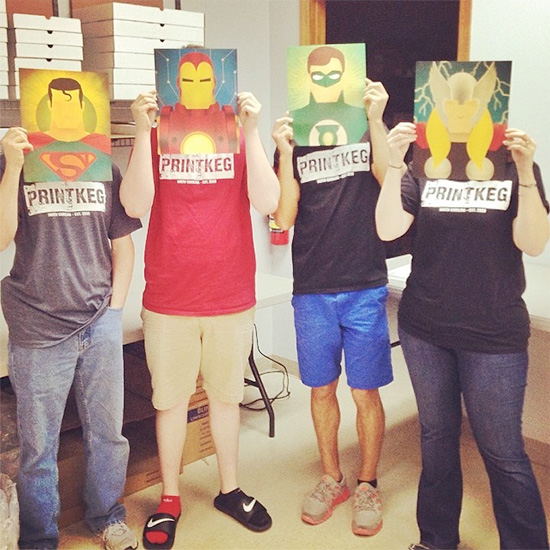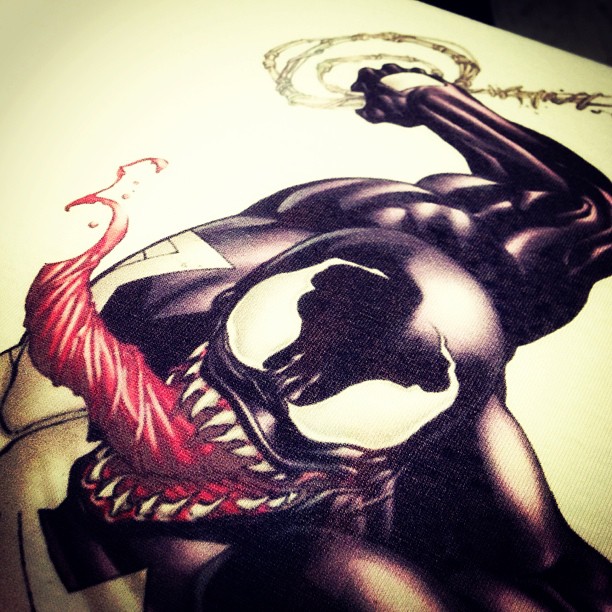
A handful of our clients are designers and entrepreneurs researching DTG printing as a way to print full color custom t-shirts for customers or to start up a new clothing brand. No doubt, direct-to-garment printing is one very cool technique of printing t-shirts that hosts a diverse set of benefits for consumers:
– full color options
– suitable for small batches
– minimal upfront investment
– quick turnaround
Large numbers of online t-shirt printing companies such as Zazzle and Cafepress rely on DTG printing for small orders such as individual shirts. Since our small online print company primarily focuses on cheap short run printing, DTG printing is a perfect way for us to complement current digital offerings while growing revenue. I was super psyched at first when we received our DTG machine, but there was a lot of headache in the beginning that I never could have imagined despite thorough research ahead of time (t-shirtforums.com is a good place to start although it is very unorganized).
I don’t want to divulge exactly what DTG machine we purchased since most of the below list reveals industry wide, and accepted, issues that may be unknown to any newcomer, yet is common knowledge to experienced professionals. I will disclose this though: We basically have an entry level machine capable of printing two to four shirts at one time.
5 Things You Should Know Before Buying A DTG Machine
1. The cost per shirt is expensive. Each DTG vender markets inaccurate cost-per-shirt numbers since they choose to only include the direct cost of successfully consumed ink. Our inks cost around $300 per liter which is hefty in itself, but ink is often wasted. For instance, each day we must perform one or two nozzle checks consuming precious ink. Dark colored shirts require pretreatment which costs an inflated $90 per gallon (optimistically good for maybe 500 to 1000 shirts). Recommended flushing and cleaning solutions and small parts required for routine daily, weekly and monthly maintenance can become profit margin eaters. These “direct” costs also don’t consider labor, utilities, supplies, etc. However, small shirt orders warrant higher individual shirt prices which can still lead to decent profit margins, but managing the expenses can become overwhelming.
2. You need at least two heat presses. Most DTG vendors will recommend that you buy at least one heat press, but this will likely become a bottleneck for production. Curing a shirt properly takes three minutes and pretreated shirts require 30 to 45 additional seconds. I personally like to heat up a shirt 5 to 10 seconds before even getting started for flattening purposes and for evaporating unwanted existing chemicals. While a shirt is curing, it is nice to be able to continue the pretreatment process and will save tons of labor even for smaller facilities.
3. Maintenance is required. Every single day, the DTG machine must be cleaned. Each vendor has its own procedures that are very similar. Nozzle checks, head cleanings, print head cleanings, ink level checks, flushing and more are continuous steps to maintaining a smooth printing process. The DTG machine is more finicky than any of our other digital printing machines which include wide format printers and digital production presses. I cannot stress enough how important maintenance is. I’ve personally had to recover a machine after an unclean operator failed to follow good care routines and it is a royal pain and source of great aggravation. You must accustom yourself to the working parts and places that consistently require attention or the printing experience will become insanely frustrating. If cleanliness is not in your nature, find another way to make money.
4. Support is mediocre. The more you print shirts, the less you will need support. Manuals and online documentation just aren’t always enough to help with certain problems. I cannot speak for all vendors, but ours recently launched a number of YouTube videos which made life much easier for me personally. However, support can often times be clunky, inconsistent and slow. Oh sure, some DTG support techs will read this and curse me, but when a call back takes more than 24 to 48 hours (if at all), or technicians sometimes provide opposing solutions or there is little online tracking of past support tickets (in our case NONE), I promise my complaints are rather justified. Not to mention, onsite service is normally unavailable or would cost anywhere from $500 to $1500 per visit. When our machine arrived with a faulty print head, the company still charged us $500 to visit our location to replace it. Don’t get me wrong, I don’t dislike the company, but DTG is still in a rather primitive state and the support can be frustrating especially in a situation where a shirt project is due right away.
Weird stuff happens when printing on shirts with a DTG machine. Platens may need to be leveled, sensors adjusted, lines cleaned, streaking occurs, dirty prints appear etc. Even newcomers following maintenance guidelines are likely to run into numerous problems and support will become frustrating. Just stick with it and things will get better eventually.
5. Give it time. The less exposed to printing and graphics software an operator is, the longer it will take to learn and digest the ropes of DTG printing. Also, different shirts and graphics may require different RIP software settings which will lead to an enormous amount of waste in the first few weeks. For some new businesses, launching professional-grade production may take months. I recommend offering free shirts to family, friends and some customers to keep the machine running and to speed up the learning process. Understanding how to trim, size and crop using Adobe Photoshop is an absolute requirement.
The below video is an example of a DTG machine printing on black shirts. Most DTG machines (like this one) can print on light and dark shirts by adding a white ink base.
Conclusion
Printing on garments like t-shirts using a DTG machine is rewarding, but watching profitability will always be a concern especially with entry level models. At first, the experience might be frustrating, but strictly following maintenance procedures and practicing will lead to high quality printed graphics and happy customers.


